Beef Rendang is one of the best South East Asian curries and not to be missed! It’s made of buttery tender beef smothered in a spicy, rich, caramelized, coconut curry sauce and is easier to make than you think!
Beef rendang is a popular Indonesian/Malaysian curry known for its incredible depth and complexity of flavor, thick sauce and juicy, meltingly tender beef. It’s made by simmering chunks of beef in a fragrant coconut curry bath bolstered with lemongrass, galangal, kaffir lime leaves, shallots and tamarind for hours until the beef drinks up the sauce and all that’s left is a thick, aromatic coating and caramelized, fall apart tender beef. This beef rendang recipe is best if you can make it to the Asian market, but I’ve also included pantry friendly substitutions to make your life easier. Once you gather your ingredients, this beef rendang recipe is easy and straightforward to make – most of the time is hands-off simmering and you’ll be rewarded with juicy, aromatic, buttery tender beef in your own kitchen. Serve beef rendang over coconut rice and prepare yourself to skip the takeout forever.
Beef rendang may be the king of curries, but every king needs a queen! For some quick, weeknight curry recipes, don’t miss Panang curry, red curry, yellow curry, coconut curry, green curry and mango curry.
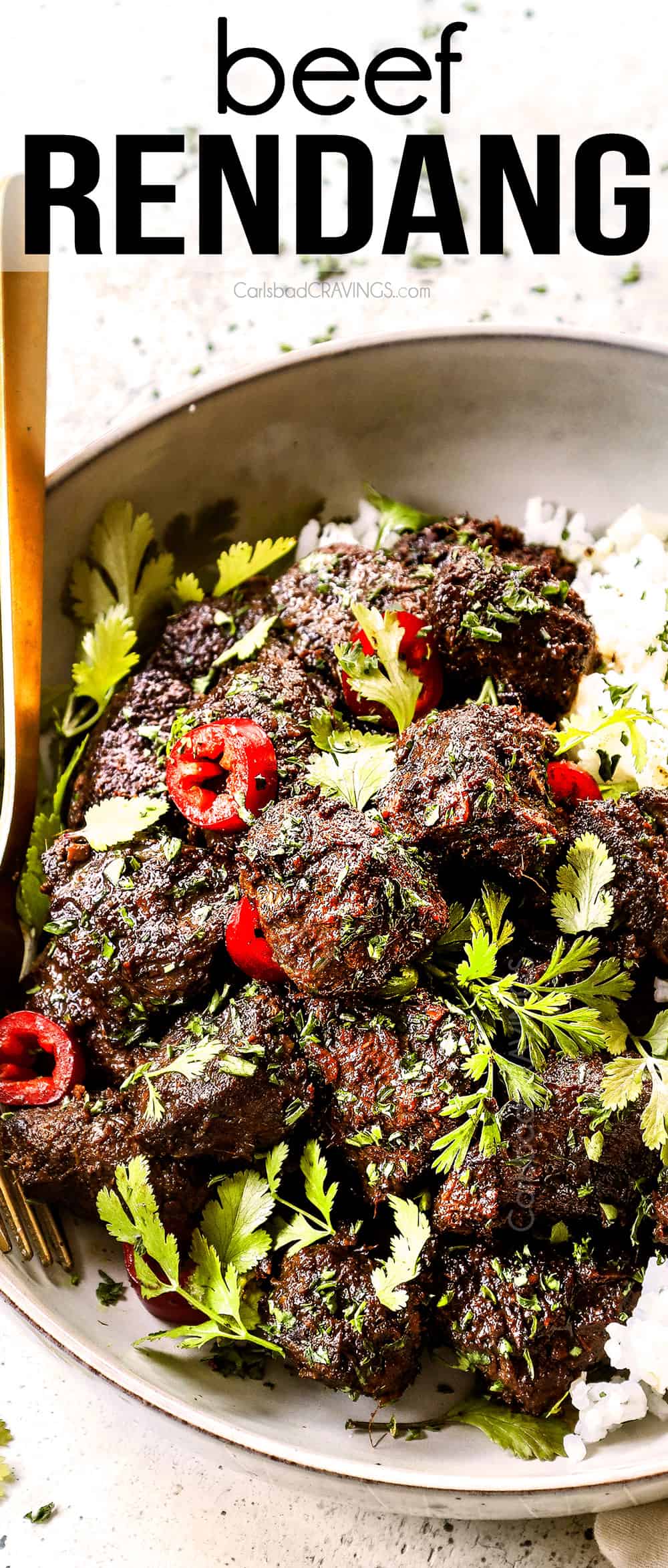
pin this recipe to save for later
What is Beef Rendang?
Beef rendang (“rendang daging” in local language), is the signature dish of the Minangkabau culture (ethnic group in Indonesia), but its influence is widespread. It has grown into arguably the most famous beef recipe not only in Indonesia, but in Malaysia and Singapore as well; for good reason. While it’s hard to describe the deliciousness that is beef rendang, I will try…
Beef rendang is an Indonesian/Malaysian beef curry made with a creamy coconut-milk based sauce that bubbles for hours, reducing into a thick, enveloping paste over the spoon-tender beef. This means beef rendang is a dry curry, without a lot of sauce. It also means the clinging sauce you do have is explosively flavorful.
As the sauce reduces, it infuses into the beef and intensifies in tropical, nutty, buttery sweetness and aromatic flavor. It boasts a healthy punch of heat from Thai chili peppers supported by an ensemble cast of extraordinary complex flavors. You have a symphony of fresh, aromatic ingredients such as lemongrass, galangal, kaffir lime leaves, shallots, tamarind and kerisik (toasted, ground coconut) and spices such as cardamom, cinnamon, cloves and star anise. They all simmer together with the beef to create a hypnotic blend you will have to taste to believe.
As the beef slowly braises in the reducing coconut curry, it’s infused with the aromatic flavors, becomes unbelievably tender, and caramelized, leaving you with golden, even slightly crispy beef chunks giving way to spoon tender beef. The beef rendang is served over rice where it literally falls apart with each extravagantly delicious forkful.
ORIGINS OF RENDANG
Rendang, including beef rendang, chicken rendang and lamb rendang, originated from the Minangkabau ethnic group of West Sumatra, Indonesia. It was, and still is, served at ceremonial occasions such as wedding feasts.
Rendang has also become popular in Malaysia, Singapore, Brunei, and the the Maranao in the Philippines (southern indigenous people who are the “people of the lake”). Rendang was brought to these peoples as Minangkabau settlers from Sumatra migrated to the southern part of the Malay peninsula during the era of the Melaka Sultanate. (The Malay peninsula contains Peninsular Malaysia, Southern Thailand, and the southernmost tip of Myanmar and the city state of Singapore).
During this era, its capital, Malacca City (in southwestern Malaysia), grew into one of the most important transshipment ports of its time, and became the center of cultural, religious and intellectual exchange. It was during this time and the enculturation of a Malay identity, that rendang was shared, adopted and celebrated by all of the people of Malay.
Beef rendang recipe
Today, I’m brining you a beef rendang recipe that tastes authentic but with an easier approach that makes more sense. The ingredient list might look daunting, but you should easily be able to find all of the ingredients at your Asian market or Amazon; and when all else fails, I’ve included easy substitutes. As a disclaimer, I must say using all substitutes will deprive you of the true sumptuous rendang experience, but if you use one or two, no will be the wiser.
Beef rendang may seem like it’s complicated due to the exotic ingredients, but it requires more patience than actual work. The method of cooking is actually very easy:
- Process curry paste in your blender
- Brown the beef
- Sauté curry paste
- Add all of the ingredients to the pot and simmer until fall apart tender!
The hardest part will be waiting through the simmering as your home fills with the tantalizing aroma of caramelized coconut curry.
Another plus about this recipe is that it’s ideal for meal prep because it tastes exponentially more delicious the next day, and it keeps well for several days. It also makes a great freezer meal(s). In fact, I recommend doubling the curry paste and freezing it, or even doubling the entire recipe, it will just take a little longer to cook. You’re already going to all the work, you might as well get double the reward! When dinner time comes the only thing you’ll need to do is pop some coconut rice in your rice cooker and prep some quick veggies. My kind of dinner!
Is this recipe authentic?
This recipe is not authentic as written, but close. In authentic beef rendang recipes, whole cardamom and whole cloves are toasted in the pot before the braising ingredients are added. Instead of whole spices, however, I’ve opted for powder forms which do not change the flavor profile. I found powders necessary because it’s practically impossible to pick out the whole spices once the rendang is finished cooking – and no one wants to bite into that! Additionally, I use toasted shredded coconut instead Kerisik, which delivers the same flavor without all of the work.
Lastly, authentic recipes sauté the curry paste and then add the beef to the paste to cook. Using this method, the beef doesn’t sear. Instead, I prefer browning the beef for maximum flavor and then sautéing the curry in the beef drippings. And that’s it! All the flavor of authentic beef rendang with improved techniques that just make sense.

What cut of beef to use?
Boneless chuck roast is the best cut of beef for beef rendang. It boasts a succulent, beefy flavor and melt-in-your mouth texture due to its rich marbling. It is guaranteed to become fall apart tender when cooked long enough. Purchase a single piece from your butcher (I like Costco) and chop it yourself to ensures uniform pieces.
You may also use other slow cooking cuts of beef such has beef cheeks, short ribs and brisket, but they may take longer (especially the brisket) to become tender. Leaner cuts, such has brisket, also won’t be as juicy.
I would also avoid stew meat because you need larger uniform pieces of meat that take longer to cook while the curry sauce reduces. Additionally, stew meat is a hodgepodge of different cuts of meat all packed together that all cook differently due to their different meat to fat ratio so you are left with tender bites, tough bites and rubbery bites – all in the same dish!
What’s in This Beef Rendang Recipe?
In addition to the beef, here’s what you’ll need for this beef rendang recipe (I’ve included substitutions below):
FOR THE CURRY PASTE
The curry paste ingredients are processed until smooth in the blender and then sauteed to bloom the spices.
- Dried Thai chilies: are one-half to two inches long. These chilies range from 50,000 to 100,000 Scoville heat units which is 23 times the average heat of a jalapeño! There are many different types of dried chile peppers so make sure you purchase the correct chilies or adjust the recipe accordingly. Remember the smaller the chili pepper, the spicier! You can find Thai chilies an Asian market or on Amazon.
- Shallots: have a delicate and sweet flavor with a hint of sharpness. You’ll need 3 shallots, which includes all of the bulbs in the shallots, so typically 6 bulbs.
- Galangal: is like ginger, but with a more peppery flavor. It is available at Asian markets or see substitution below.
- Garlic: I use 6 garlic cloves but you may use more or less depending on your garlic love.
- Lemongrass: is one of my favorite ingredients and easy to work with, so don’t be intimidated! It adds a complex slightly sweet, pungent, and lemony taste. I also use it in my Lemongrass Chicken, Tom Kha Gai, Tom Yum, Laksa and Vietnamese Noodles, so it’s definitely worth becoming familiar with. When selecting lemongrass at the store, look for stalks that are firm but slightly pliable rather than soft and rubbery or dried out and brittle. Look for stalks that transition from pale yellow at the base to bright green in the husks and avoid stalks with leaves that are starting to brown.
- Where can I find lemongrass?: You may be able to find lemongrass in the produce section of your local grocery store or definitely at specialty stores such as Sprouts, Whole Foods or an Asian Market. Sometimes my Sprouts only carries it by the stalk already chopped into 4 sections in a plastic container, so, if you can’t find it, make sure to ask someone.
- Spices: ground turmeric, ground cinnamon, ground cloves, ground nutmeg add complex flavor to the curry paste. As previously discussed, I don’t recommend whole spices because they are hard to pick out after cooking and you will inevitably crunch down on one.
FOR BRAISING
The curry paste is sauteed and then added with other ingredients to braise the beef. These ingredients include:
- Coconut milk: you need canned coconut milk for this recipe, not the kind that comes in a carton. I recommend using full-fat coconut milk for the best flavor but you may substitute with light.
- Beef broth: is combined with the coconut milk to braise the beef. Using only coconut milk is too thick and using water is flavorless, but beef broth is perfect! Use low sodium beef broth so the recipe isn’t too salty.
- Tamarind paste: a sour, citrusy paste with subtle notes of smoke and caramel made from the fruit that grows in a pod on a tamarind tree, native to Africa and Asia and Mexico. You can make tamarind paste yourself, but it’s easy to grab on Amazon, or at your local Asian market, is inexpensive and keeps for an extended period of time. See substitution below.
- Shredded coconut: authentic beef rendang uses Kerisik, which is a coconut paste commonly used in Indonesian dishes. It is made by grating fresh coconut, frying it then grinding git into a paste. It’s just way too much work to make it from scratch when most of the work has done for you in the form of shredded coconut! For this recipe, you’ll need unsweetened coconuts sold in packages at the grocery store. We’ll then toast it in a skillet for a few minutes to create the same flavor as Kerisik.
- Lemongrass: you’ll use some lemongrass in the curry paste and 1 stalk lemongrass for the braising liquid.
- Kaffir lime leaves: add the complex, unique citrus and herbaceous notes crucial to many South East Asian dishes. It’s difficult to create an exact facsimile, so it’s best to pick them up fresh at an Asian market or you can use dried kaffir lime leaves from Amazon which are super convenient and last for about a year.
- Palm sugar: is a natural sugar made by boiling the sap collected from palm flowers until it is reduced to sugar crystals. It has hints of caramel and maple with smoky overtones.
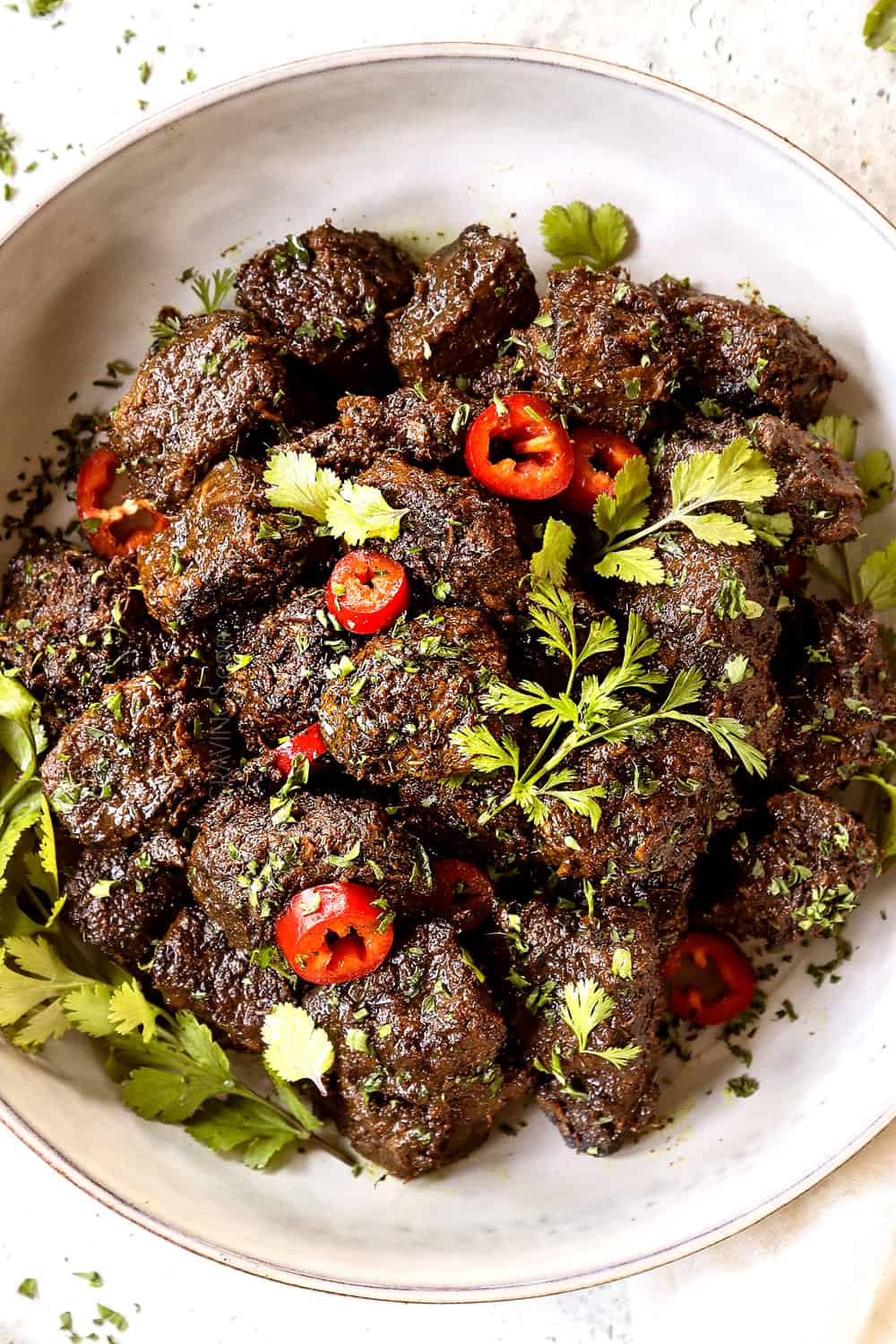
Beef Rendang ingredient Substitutions
In an ideal world, this beef rendang recipe would be made with fresh, authentic ingredients, but I understand you not wanting to purchase tamarind paste just for 2 teaspoons! Fortunately, there are some simple, pantry friendly substitutes for many of the more exotic ingredients. They won’t boast the exact same complex flavors, but your beef rendang will still be spectacular.
- What Can I Substitute for Galangal? Galangal tastes much like ginger with the complexity of pungent, pepper-pine undertones. So basically, it is ginger on steroids. However, you can also make this recipe by substituting the galangal with ginger and a healthy dose of freshly cracked black pepper. If making a trip to the Asian market is easy for you, then go with the galangal, but you won’t be disappointed if you use the ginger substitute instead.
- What can I substitute for tamarind paste? A decent substitute is 2 teaspoons freshly squeezed lemon juice or 2 teaspoons white vinegar. If you already have tamarind pulp (sticky block of dried tamarind), soak 2 teaspoons in 2 tablespoons of hot water and remove the seeds.
- What Can I substitute for lemongrass? If fresh lemongrass is hard to come by, there is always paste! Substitute 1 teaspoon paste for every stalk of lemongrass the recipe calls for. So, for this recipe, use 3 teaspoons (1 tablespoon) paste in the curry paste and add 1 teaspoon to the braising liquid.
- What Can I Substitute for Kaffir Lime Leaves? You can use a combination of ingredients to closely mimic the complex flavor; it won’t be an exact replica, but a close one. In the place of kaffir lime leaves, use 4 bay leaves plus 1 tablespoon lime juice and the zest of one lime. The bay leaves offer the strong herbal flavor and the lime zest adds the sharp, clear citrus punch.
- What can I use in place of palm sugar? Palm sugar has more complexity than white sugar and brown sugars, but we’re only using 1 tablespoon, so it’s perfectly acceptable to swap it out for brown sugar.
- What can I use instead of Thai chilies? If you can’t locate Thai chiles, you may substitute them with any other chilies as long as you google the Scottsville heat unit (SHU) in the chili pepper you want to use and calculate how many chilies you need to equal the same heat as Thai chilies. The higher the Scoville rating, the hotter the pepper. For example, Thai chili peppers have 50,000 to 100,000 SHU compared to the following:
- Cayenne: 30,000-50,000 SHU
- Chili de arbol 15,000-30,000 SHU
- Serrano 10,000-23,000 SHU
How to Make Beef Rendang
Now to the main event! Making beef rendang is very easy, but it does require a few hours of hands-off simmering, so don’t rush the process. Your beef rendang is done when it’s literally fall apart tender. I’m going to break down the steps and hopefully answer all of your questions as we go.
Step 1: Make curry paste
- Soften chilies: first, we need to soften the dried Thai chilies or you’ll end up with stubborn chunks of hard chilies in the curry paste. To soften the chilies, boil them in water for 5-10 minutes, until softened. Add ½ cup of the simmering liquid to a high-powered blender along with drained chilies. Don’t throw out the rest of the simmering liquid. You may need a little more liquid to get your blender moving.
- Add ingredients to the blender: peel the shallots, galangal, ginger and lemongrass and add to the blender along with ground turmeric, cardamom powder, ground cloves and ground nutmeg.
- Blend until smooth: if your blender is having a hard time, add additional chili liquid, then cook the paste a little longer in the next step.
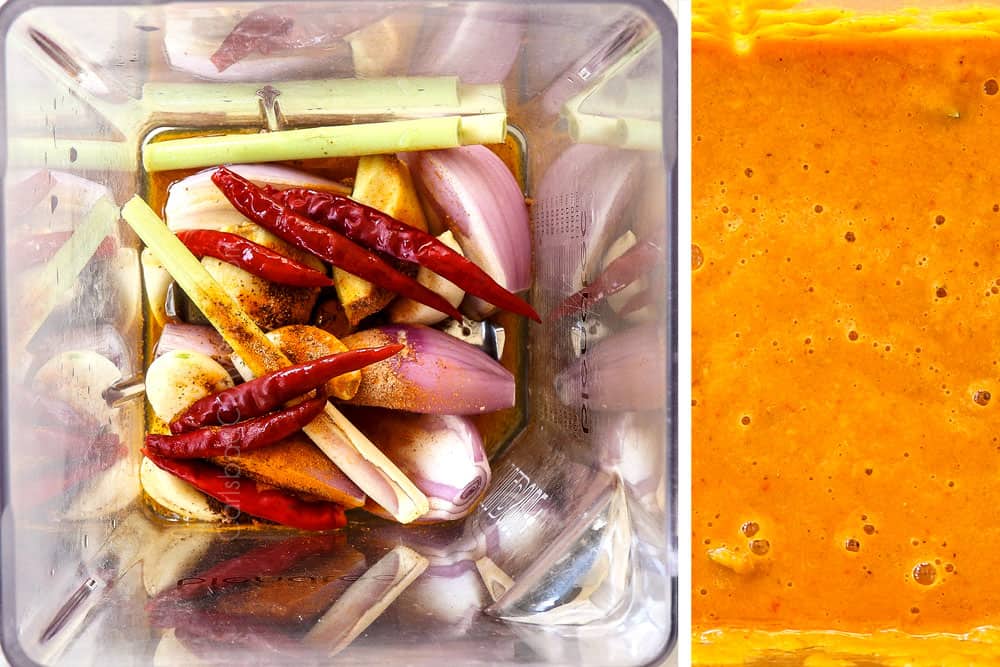
Step 2: Sear the beef
- Sear beef: use a neutral oil and wait to add the beef until the pan is super-hot. Add the beef and sear, rotating the beef with tongs until it cooks for a few minutes on each side. Go for deeply browned, because color equals flavor!
- Leave drippings: transfer the beef to a plate but leave the drippings behind. These deeply flavorful drippings will add an extra oomph of flavor to the curry paste and flavor the entire dish.
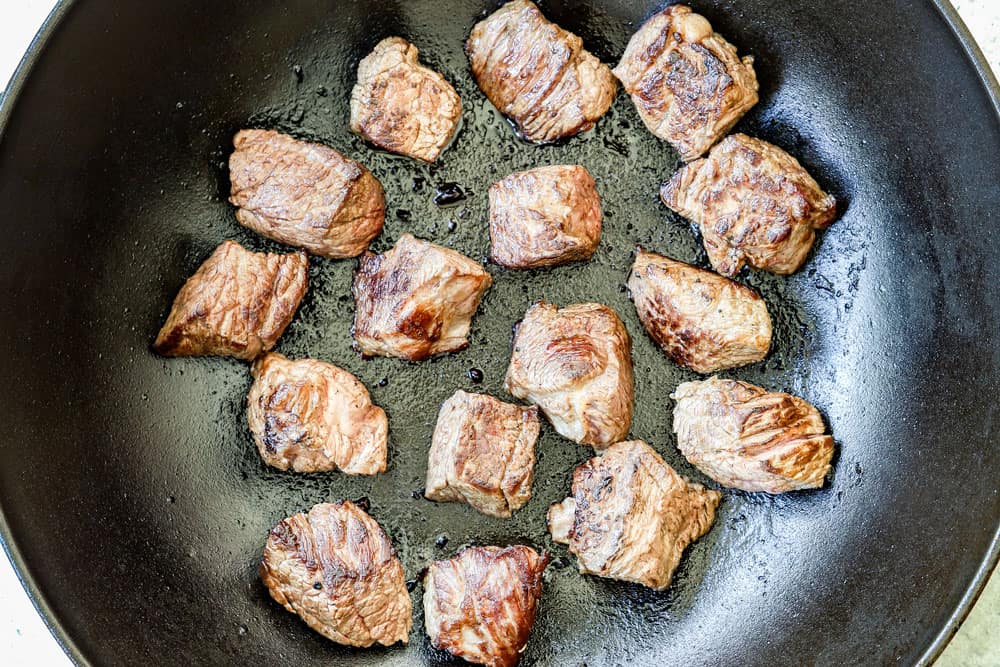
STEP 3: Sauté curry paste
- Add the curry paste and cook for 4-5 minutes, until the moisture reduces and the curry thickens, leaving you with a thick, caramelized curry paste. You may need to cook the curry paste more or less time depending on how much chili pepper liquid you added to the blender.

Step 4: Add the braising ingredients
- Add the beef back to the pot followed by the coconut milk, beef broth, lemongrass, tamarind paste, kaffir lime leaves, star anise and cinnamon, palm sugar and salt.
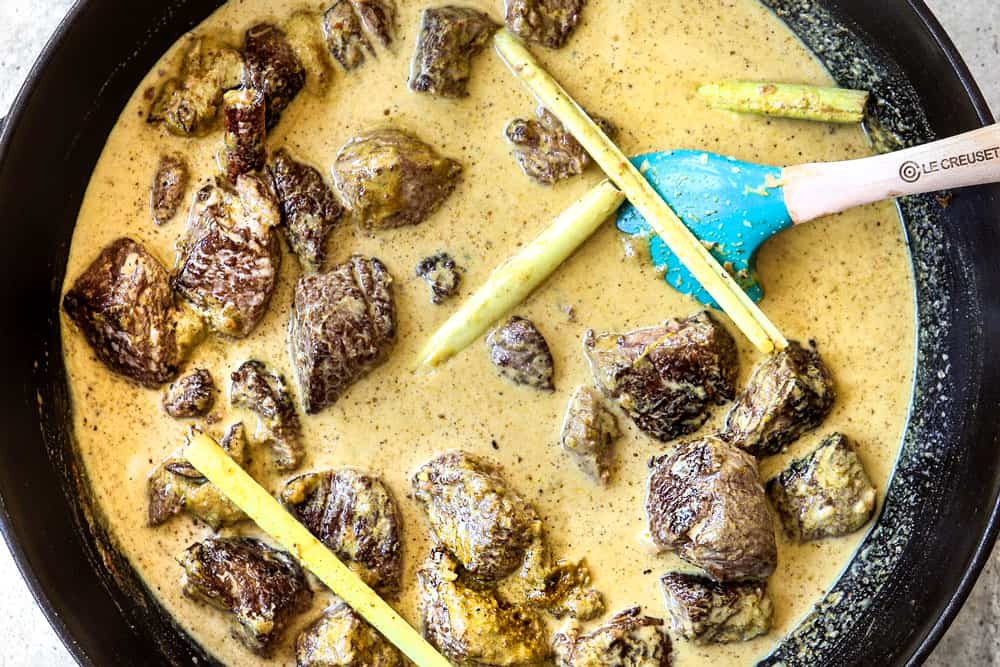
Step 5: Braise the beef
- Simmer: bring the pot to a simmer, then reduce the heat to the lowest setting possible to maintain a very gentle simmer. Cover and simmer for about 2 hours, stirring occasionally, until very tender. Stir often and recover the last 30 minutes so it doesn’t burn.
- Reduce: remove the lid and continue to cook until the beef is tender and sauce thickens into a paste to coat the beef, about 30 minutes. If the sauce thickens too much before the beef is done, add some water or beef broth and continue to cook until fall part tender.
- Serve: discard lemongrass, cinnamon and star anise before serving. Serve with coconut rice, limes and garnish with thinly sliced lime leaves.
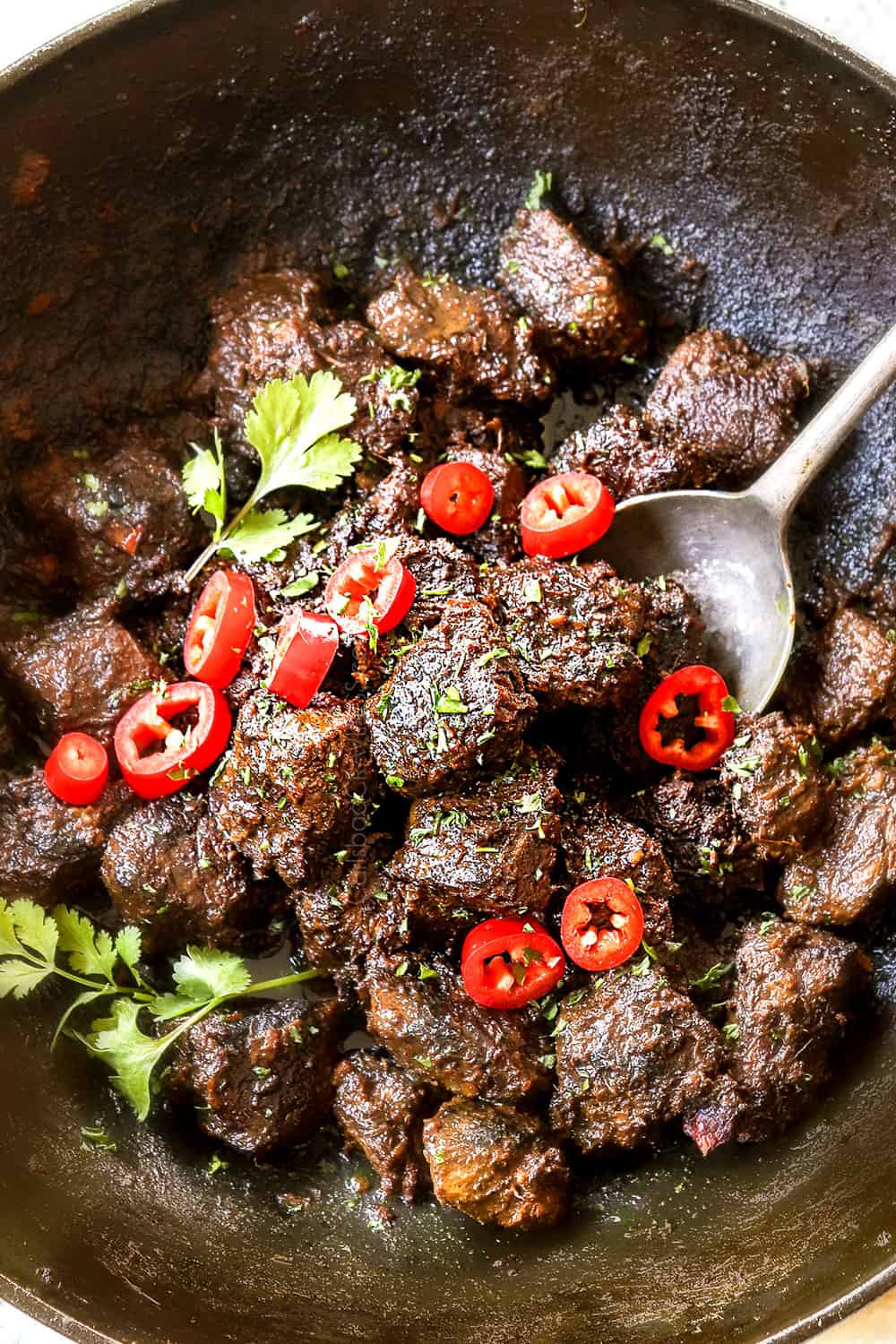
Tips for Making Beef Rendang
- How to cut lemongrass. For this recipe, we will use 4 stalks of lemongrass -3 for the curry paste and one for braising. To use the lemongrass, start by chopping off the bottom and spiky tops. Peel off the tough green outer layer to reveal the softer whitish/green part on the bottom half of the lemongrass. Chop the top reedy green part off, we only want to work with the white part and very pale green part, otherwise you’ll end up with tough, reedy pieces in your teeth! Press the stalks with the side of your knife to bruise and release the aromatic oils, then slice the them in into thirds or fourths to fit into your blender and the pot. Use ¾ for the curry and the remining lemongrass for the braising.
- Add enough water so the paste blends. If you have an older blender, you may need to add more chili liquid to the blender to get it to move, which is totally fine. Just make sure to cook the paste longer until the moisture evaporates and only a thick, caramelized paste remains.
- Blend the curry paste until smooth. This is crucial or you’ll end up with chunks of lemongrass or galangal in your teeth later.
- Don’t inhale! The curry paste is very potent, so be careful when sautéing it. Get those fans going and don’t take any deep breaths.
- Use the right cut of beef. As previously discussed, boneless chuck roast will deliver fall apart tender results due to its rich marbling. If you choose another cut of beef, be aware it might not deliver as spectacularly tender results and will take longer to cook.
- Don’t cut the beef too small. Get out your measuring tape and cut the beef into 2-inch pieces. Larger cubes of beef are better for this dish because we want them done at the same time the braising liquid reduces into a thick paste. If the beef is too small, it will cook too quickly and be literally fall apart tender, and shred as you finish reducing the curry. Not the end of the world and still delicious, just not as intended.
- Use a high smoking point oil to sear the beef. Use vegetable oil, canola oil or peanut oil because a low smoking point oil (such as olive oil) will burn – and smoke you out!
- Sear the beef in batches. For the best flavor and texture, don’t be tempted to overcrowd your pan. Sear the beef in two batches so it can brown and not just steam.
- Simmer on low. You should keep the braising liquid at a low simmer to produce the most juicy, tender meat.
- Cook the beef until tender. I learned this trick from my Mom’s Crazy Tender Pot Roast. If your beef isn’t crazy tender, then cook on! It just means the proteins needs more time to break down and tenderize. Even 30 more minutes can make the world of difference between an “okay” beef and melt-in-your-mouth beef rendang.
- Don’t be alarmed when the grease separates. At the end of cooking, the sauce reduces down to the point some of the oil separates from the beef – this is a good thing! The beef will continue to brown and caramelize in the fragrant oil until it’s deeply golden.
What to Serve with Beef Rendang?
I like to serve beef rendang with coconut rice, limes and a few thinly sliced kaffir lime leaves. Here is a variety of rice options and Asian-inspired sides that would also be tasty:
- Rice: Coconut Rice, white rice, brown rice, quinoa, cauliflower rice, broccoli rice, or Pineapple Rice.
- Stir fried veggies: sesame ginger bok choy is a quick, versatile win or pick your favorite vegetables such as bell peppers, carrots, broccoli and mushrooms and make a quick stir fry with garlic, ginger and a splash of soy sauce or red curry paste. You can even purchase pre-chopped veggies perfect for stir fries or use a frozen stir-fry blend to steam-in-the-bag.
- Roasted veggies: choose the Asian inspired flavor variations of any of my roasted vegetable recipes such as Roasted Broccoli, Roasted Broccolini, Roasted Cauliflower, Roasted Carrots, Sauteed Brussels Sprouts, or Roasted Squash.
- Appetizers: we love mixing and matching our favorite appetizers from all over Asia such as Chicken Satay, Spring Rolls, Chicken Lettuce Wraps, Pineapple Cream Cheese Wontons, Crab Rangoons, Chicken Satay, Potstickers, Pork Egg Rolls, Sesame Chicken Egg Rolls, Sweet and Sour Chicken Egg Rolls and Chinese Chicken Wings.
- Soup: let the Asian feast continue with soup! I love to warm up to Tom Yum Soup, Tom Kha Gai, Laksa, Curried Butternut Squash Soup and Thai Noodle Soup.
- Salad: is a refreshing, bright side to the savory beef rendang. Some of our favorite Asian inspired salads include Crunchy Asian Salad, Chinese Salad, and Asian Pineapple Salad.
- Fruit: fresh fruit such as chopped pineapple is always an easy, welcome sweet stir fry side. Grilled Pineapple, Summer Fruit Salad, Perfect Fruit Salad, Creamy Grape Salad, and Pina Colada Fruit Salad are also fantastic.
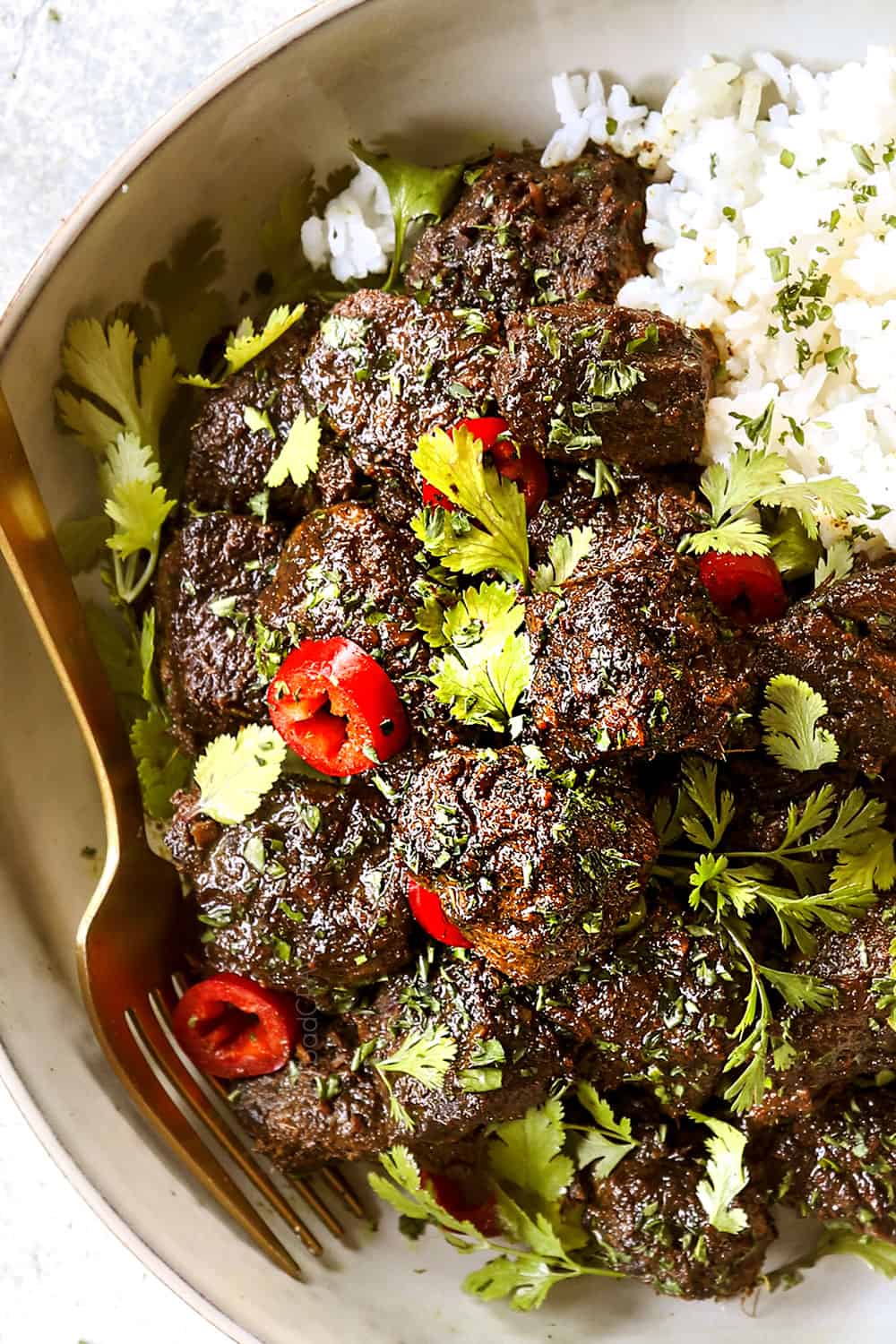
Recipe Variations
- Make it spicier: For a spicier beef rendang, use 6 whole dried chiles for the full level of spice.
- Make it less spicy: For medium spice, use 3 whole dried chilies. If you are very sensitive to heat, then use 1 Thai chili.
- Cook in the slow cooker: Follow the first steps of searing the beef and sautéing the curry then transfer all of the ingredients to the slow cooker. Cook on low for 6-8 hours. You’ll then have to transfer the curry to a large pot to reduce the sauce for 30-ish minutes before serving. (See the hassle? That’s why I don’t make it in the slow cooker)
Can I Prep This Recipe in Advance?
Yes, please do! Beef rendang is one of those recipes that gets exponentially better the next day! You can prepare the entire recipe ahead of time and reheat the next day or, you can prepare individual elements of the recipe before cooking it:
- Curry paste: rehydrate the chiles and blend up the curry paste. Store in an airtight container in the fridge for up to 1 week before using or freeze for up to 3 months.
- Beef: chop the beef and store in an airtight container in the fridge for up to 3 days.
- Assemble: follow the recipe up to combining all of the ingredients, cover and pop in the fridge. The next day, get your simmer on.
How to Store Beef Rendang
This homemade beef rendang stores beautifully! Seal it in an airtight container and refrigerate for up to 5 days.
How to Reheat Beef Rendang
- Microwave: heat the beef rendang in a microwave-safe dish for 1 minute, stir, then continue heating at 30-second intervals until warmed through.
- Stove: heat a drizzle of oil in saucepan and heat over medium heat. Add the beef rendang and warm through. You may need to add a splash of water if it looks dry at any point.
Can I Freeze Beef Rendang?
Yes! This dish freezes very well. Let it cool completely, then seal inside a freezer bag or freezer-safe container. Label and freeze up to 3 months. When ready to eat, thaw overnight in the fridge before reheating.
Looking for More Asian Beef Recipes?
- Asian Burgers
- Beef and Broccoli
- Beef Bulgogi
- Crockpot Beef and Broccoli
- Grilled Asian Steak
- Korean Beef Bowls
- Mongolian Beef
- Korean Meatballs
- All of my Asian-inspired recipes!

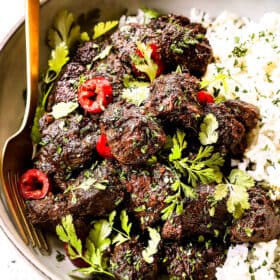
Beef Rendang
Save This Recipe To Your Recipe Box
You can now create an account on our site and save your favorite recipes all in one place!
Ingredients
Curry Paste
- 3-6 Thai whole dried chiles or fresh Birdseye chilies
- 3 shallots or ½ large onion, peeled
- 6 cloves garlic, peeled
- 3 lemongrass stalks white part only, sliced, cut into pieces (see notes)
- 1 3-inch piece fresh galangal, peeled (or ginger and a crack of pepper)
- 1 ½ teaspoons ground turmeric
- 1/2 tsp EACH cardamom powder, ground cloves, ground nutmeg
Braising ingredients
- 2 1/2 pounds chuck roast, cut into 2” cubes
- 2 tablespoon vegetable oil
- ¼ cup unsweetened shredded coconut
- 1 cinnamon stick
- 3 star anise
- 1 lemongrass, cut into 4-inch lengths and pounded
- 1 14 oz. can coconut milk
- 1 14.5 oz. can low sodium beef broth (1 ¾ cup)
- 2 teaspoons tamarind puree (may sub 2 teaspoons lemon juice)
- 4 large kaffir lime leaves, finely sliced (may sub 4 bay leaves, 1 Tbsp lime juice + the zest of 1 lime)
- 1 grated palm sugar (may sub 1 Tbsp brown sugar)
- 1 1/2 teaspoons salt
Instructions
- Toast coconut: Heat a skillet over medium-low heat. Add the shredded coconut and toast, stirring occasionally, until golden brown. Transfer to a bowl and set aside.
- Make curry paste: If using dried chilies, simmer them in boiling water for 5-10 minutes, until softened. Add ½ cup of the simmering liquid (or water if using fresh chilies) to a high-powered blender. Chop the tops off the chilies (keep the seeds) and add to the blender along with all remaining curry paste ingredients; blend until very smooth. Add up to ¼ cup additional liquid if needed to blend; set aside.
- Sear beef: Heat 1 tablespoon oil in a 3.5 quart or larger Dutch oven over high heat. Once hot, add half the beef and sear on all sides; remove to a plate and repeat with remaining beef.
- Make curry: Reduce heat to medium-low. Add curry paste to the empty pot and cook for 4-5 minutes or until the moisture reduces and the curry thickens into a paste and begins to caramelize.
- Braise: Add all of the braising ingredients to the pot with the curry paste, including the beef. Bring to simmer, then reduce heat to the lowest setting to maintain a very gentle simmer. Cover and simmer for 1 1/2-2 hours, stirring occasionally, until very tender. Stir often (and recover) the last 30 minutes so it doesn’t burn.
- Reduce: This step may not be needed if your sauce reduced completely with the lid covered. Remove the lid and continue to cook until the beef is fall apart tender and sauce thickens into a paste to coat the beef, about 20 minutes, stirring often. If the sauce thickens too much before the beef is done, add a water and continue to cook until fall part tender.
- Serve: Discard lemongrass, star anise and cinnamon before serving. Serve with coconut rice and limes.
Notes
- Thai chilies: slice the tops of the chilies but keep all of the seeds. Use 3 for mild and up to 6 for spicy. You may use different chili peppers and adjust the recipe as needed by googling the Scoville Heat Units (SHU) of your chilies. For example, Thai chili peppers range from 50,000 to 100,000 SHU compared to cayenne chili peppers that range from 30,000-50,000 SHU, so if you use cayenne, you would need roughly double the number of chilies to equal the same SHU as Thai chilies.
- Lemongrass: you may be able to find lemongrass in the produce section of your local grocery store or definitely at specialty stores such as Sprouts, Whole Foods or an Asian Market. Sometimes my Sprouts only carries it by the stalk already chopped into 4 sections in a plastic container, so, if you can’t find it, make sure to ask someone. To use the lemongrass, start by chopping off the bottom and spiky tops. Peel off the tough green outer layer to reveal the softer whitish/green part on the bottom half of the lemongrass. Chop the top reedy green part off, we only want to work with the white part and very pale green part, otherwise you’ll end up with tough, reedy pieces in your teeth! Press the stalks with the side of your knife to bruise and release the aromatic oils, then slice the them in into thirds or fourths to fit into your blender and the pot.
- Spices: I don’t recommend whole spices (except where mentioned) because they are hard to pick out after cooking and you will inevitably crunch down on one.
- Don’t be alarmed when the grease separates: At the end of cooking, the sauce reduces down to the point some of the oil separates from the beef – this is a good thing! The beef will continue to brown and caramelize in the fragrant oil until it’s deeply golden.
Make Ahead
Beef rendang is one of those recipes that gets exponentially better the next day! You can prepare the entire recipe ahead of time and reheat the next day or, you can prepare individual elements of the recipe before cooking it:- Curry paste: rehydrate the chiles and blend up the curry paste. Store in an airtight container in the fridge for up to 1 week before using or freeze for up to 3 months.
- Beef: chop the beef and store in an airtight container in the fridge for up to 3 days.
- Assemble: follow the recipe up to combining all of the ingredients, cover and pop in the fridge. The next day, get your simmer on.
How to Store and Reheat
- How to store: seal in an airtight container and refrigerate for up to 5 days.
- How to freeze: let the dish cool completely, then seal inside a freezer bag or freezer-safe container. Label and freeze up to 3 months. When ready to eat, thaw overnight in the fridge before reheating.
- How to reheat in the microwave: heat the beef rendang in a microwave-safe dish for 1 minute, stir, then continue heating at 30-second intervals until warmed through.
- How to reheat on the stove: heat a drizzle of oil in saucepan and heat over medium heat. Add the beef rendang and warm through. You may need to add a splash of water if it looks dry at any point.

Did You Make This Recipe?
Tag @CarlsbadCravings and Use #CarlsbadCravngs
Leave a Review, I Always Love Hearing From You!
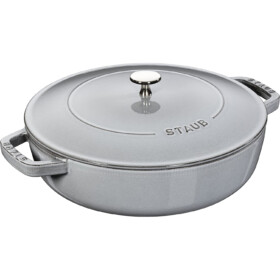
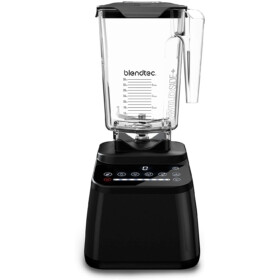
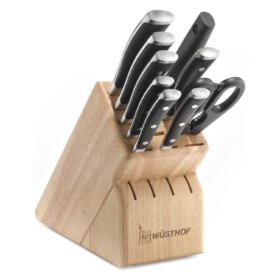
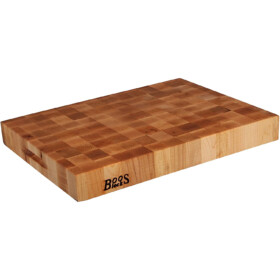
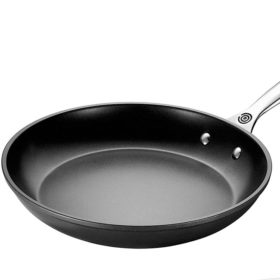
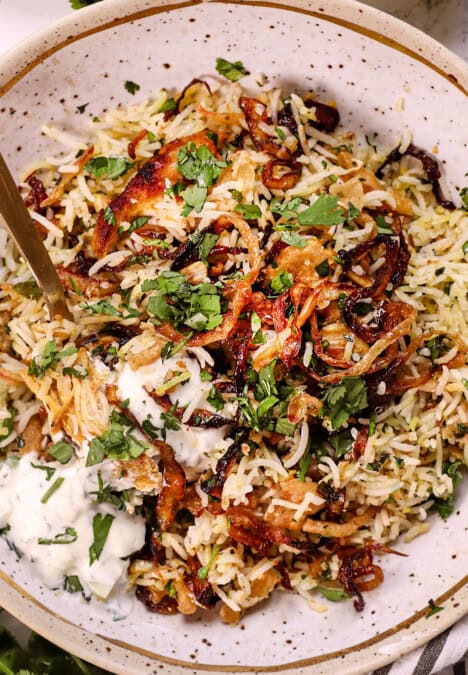
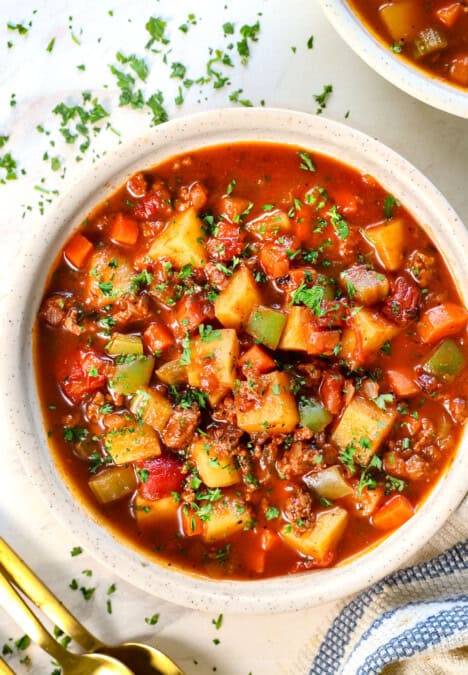

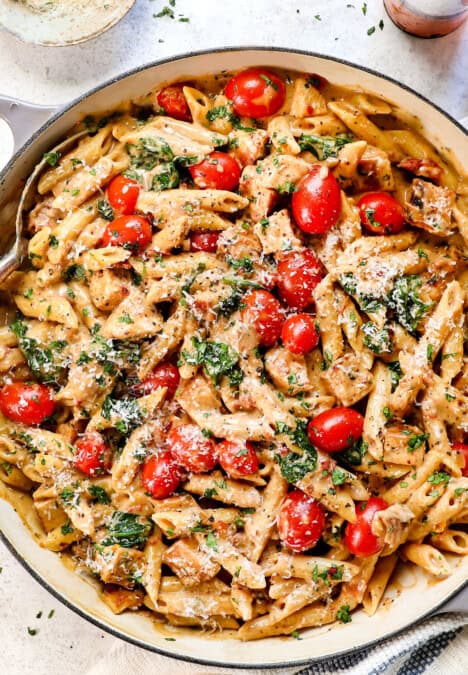
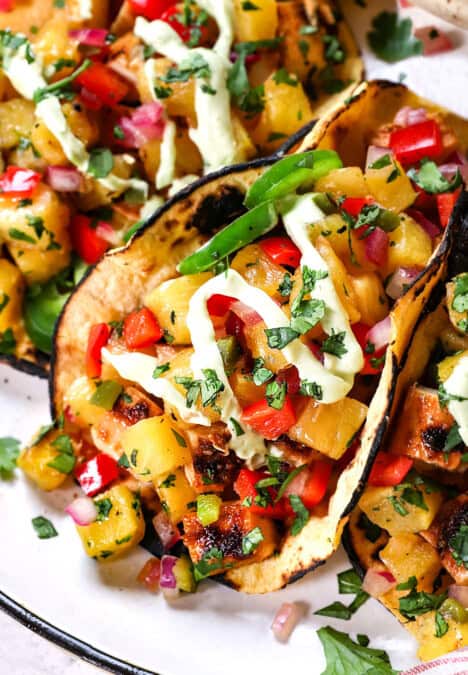
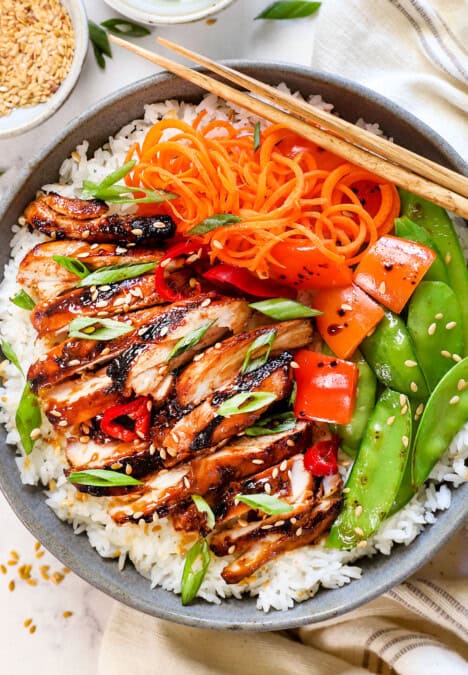























Ramya says
will be making this soon can i use mushrooms and vegetable broth as am a vegan both malaysia and indonesia near to Singapore am in Singapore perfect for your coconut rice or naan do you have a naan recipe on your website will dm you if i make this and let you know how it goes Thanks Ramya
Jen says
I don’t have a naan recipe yet but I’ll make sure to post one soon!
Rachel says
Oh, my gosh, I just about died when I opened my email this morning and saw what recipe you were sharing today! I love beef rendang, but it can be so hard to find. This sounds absolutely amazing, and I have already ordered the Thai chiles and kaffir lime leaves. I am so excited to make this!
Jen says
YAY! I’m thrilled you were so excited! I can’t wait for you to make it and hear what you think!